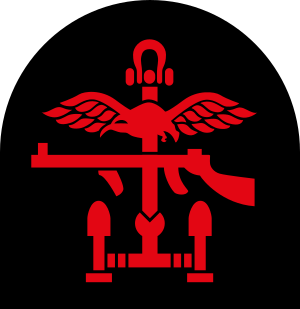Combined Operations Headquarters facts for kids

Combined Operations badge
|
|
| Agency overview | |
|---|---|
| Formed | 1940 |
| Dissolved | 1947 |
| Superseding agency |
|
| Jurisdiction | Government of the United Kingdom |
| Headquarters | War Office building Whitehall London |
| Parent agency | War Office |
The Combined Operations Headquarters was a special part of the British War Office during Second World War. Its main job was to plan and carry out surprise attacks on German forces in Europe. These attacks used both naval (sea) and army (land) forces working together.
Contents
What Was Combined Operations Headquarters?
This group was set up to make sure the Royal Navy (ships), British Army (soldiers), and Royal Air Force (planes) worked closely. They would use ships and planes to deliver special soldiers called Commandos to their targets. After the mission, they would also help bring them back. This way of working together was called "combined arms coordination."
The headquarters had staff who planned missions. They also developed new ideas and equipment to bother the enemy. They were also in charge of all the special boats, from small landing craft to large landing ships. These boats were used to carry soldiers and equipment from ships to shore during attacks.
The badge of Combined Operations showed an Albatross (for the Air Force), over a submachine gun (for the Army), over an anchor (for the Navy). This badge showed that all three parts of the military worked as one team.
The department started in 1940 and continued until 1947. Later, in 1951, a similar group called the Amphibious Warfare Headquarters was formed.
Who Led Combined Operations?
Several important leaders were in charge of Combined Operations:
- Admiral of the Fleet Roger Keyes was the first director. He led from July 1940 to October 1941.
- He was followed by Lord Louis Mountbatten. Lord Mountbatten first held the title of "Adviser Combined Operations" from October 1941. In 1942, his title changed to "Chief of Combined Operations." He led until September 1943.
- Finally, Major General Robert Laycock took over in October 1943 and led until 1947.
Important Missions and Projects
Combined Operations Headquarters planned and carried out many important missions. Here are some examples:
- Operation Collar (June 1940) – This was the very first Commando raid on German-occupied Europe.
- Operation Claymore (March 1941) – A raid on the Lofoten Islands to destroy factories that made fish oil.
- Operation Archery (December 1941) – An attack on German positions on the island of Vågsøy.
- Operation Chariot – A famous raid on the port of St. Nazaire.
- Operation Jubilee (August 1942) – This was the Dieppe raid, a large-scale attack.
- Operation Biting – A mission where a German Würzburg radar was captured.
- Operation Frankton (the "Cockleshell heroes") – A daring attack using canoes on ships in France.
- Mulberry harbours – These were special portable harbours built for D-Day. They were used to land supplies on the beaches of Normandy.
- Operation Pluto – This project involved building petroleum pipelines under the English Channel to supply fuel after D-Day.
- Project Habakkuk – This was a very unusual project to develop giant ships made of ice.
- Exercise Tiger – A training exercise for D-Day that sadly resulted in many lives lost due to an enemy attack.
- Operation Freshman – An attack on a chemical plant in Norway.
Special Units
Combined Operations also included special units:
- Combined Operations Pilotage Parties (COPP) – This unit had members from the Navy, Marines, Army Engineers, and Special Boat Service. Their job was to secretly check out landing sites for invasions, like those in Sicily and Normandy.
- Small Scale Raiding Force – Also known as "No. 62 Commando," this was another special raiding unit.
In Film
The film Attack on the Iron Coast shows a story about Allied Combined Operations Headquarters commandos carrying out a brave raid on the French coast during the Second World War.

